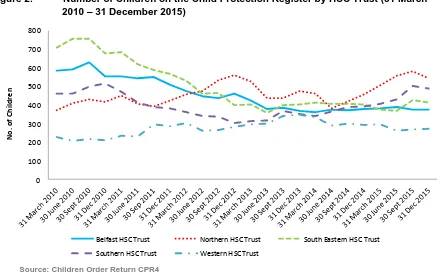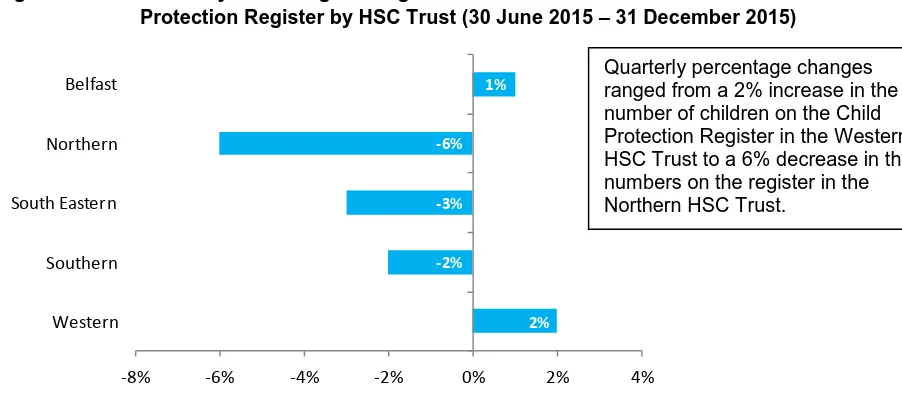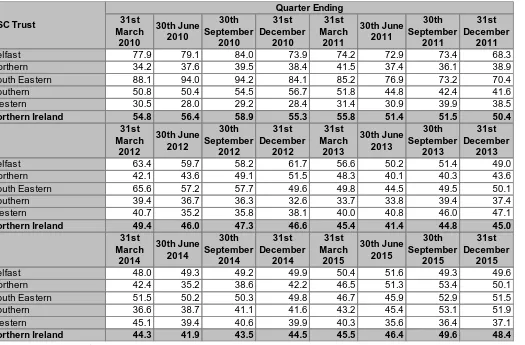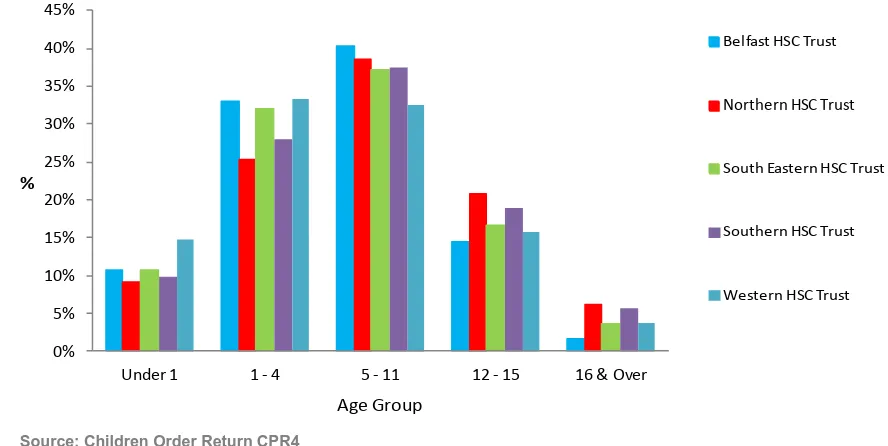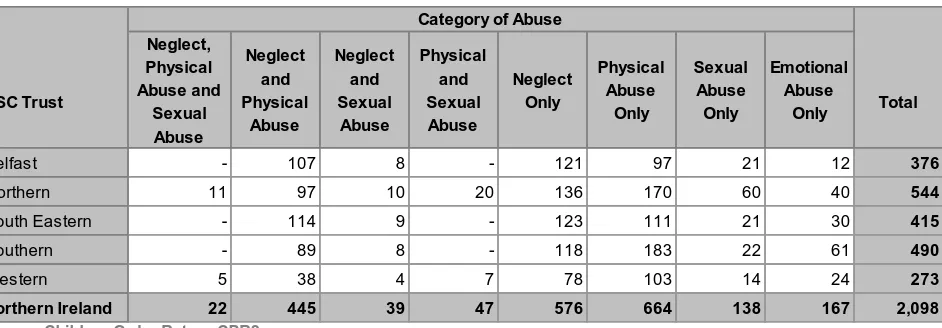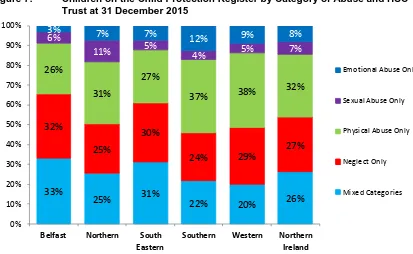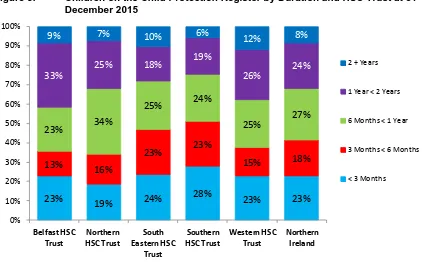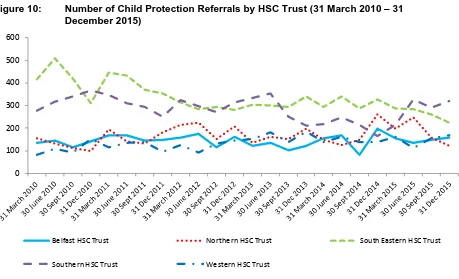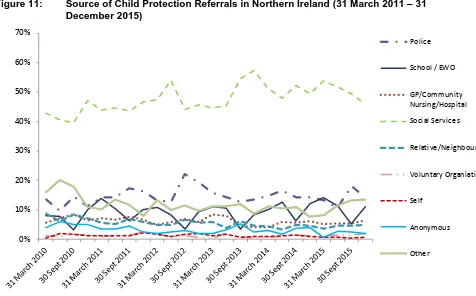Child Protection Register
Quarterly Child Protection
Statistics for Northern Ireland
(October – December 2015)
Child Protection Statistics Page 2
Reader Information
Authors
Iain Waugh, Heidi Rodgers
Publication Date
18 February 2016
Issued by
Community Information Branch
Information & Analysis Directorate
Department of Health, Social Services & Public Safety
Stormont Estate, Belfast, BT4 3SQ, Northern Ireland
Tel (028) 90522580
cib@dhsspsni.gov.uk
https://www.dhsspsni.gov.uk/topics/dhssps-statistics-and-research
Target Audience
Social Services Directors, Directors of
Children’s
Services, Chief Executives of HSC Board and Trusts
in Northern Ireland, health care professionals,
academics and social care stakeholders.
Main uses of document
Data from this publication is used to monitor the
delivery of social care services to children, to help
assess Health and Social Care (HSC) Trust
performance, corporate monitoring, to inform and
monitor
related
policy,
and
to
respond
to
parliamentary/assembly questions. The bulletin is also
used by academics/ researchers, the voluntary sector
and those with an interest in child protection.
Copyright
This publication is Crown copyright and may be
reproduced free of charge in any format or medium.
Any material used must be acknowledged, and the
title of the publication specified.
Statistics and research for the Department of Health, Social Services and Public Safety is provided by the Information and Analysis Directorate (IAD). IAD is responsible for compiling, processing, analysing, interpreting and disseminating a wide range of statistics covering health and social care.
The statisticians within IAD are out posted from the Northern Ireland Statistics & Research Agency (NISRA) and the statistics are produced in accordance with the principles and protocols set out in the Code of Practice for Official Statistics.
https://www.dhsspsni.gov.uk/topics/dhssp s-statistics-and-research
IAD comprises four statistical sections: Hospital Information, Community Information, Public Health Information & Research and Project Support Analysis.
This publication is produced by Community Information Branch.
Our Vision and Values About Community Information Branch Provide up-to-date, quality information
on children and adult social services and community health;
to disseminate findings widely with a view to stimulating debate, promoting effective decision-making and improvement in service provision; and
be an expert voice on social care information.
The purpose of Community Information Branch (CIB) is to promote effective decision making in children and adult social services by providing quality information and analysis.
We collect, analyse, and publish a wide range of community information that is used to help monitor the delivery of personal social services policy. Information collected by CIB is used to assess HSC Trust performance, for corporate monitoring, policy evaluation, and to respond to
parliamentary/assembly questions.
https://www.dhsspsni.gov.uk/topics/dhssp
s-statistics-and-research-social-services/social-care-statistics
Child Protection Statistics Page 4
Contents
Key Findings ... 5
Introduction ... 6
Background ... 6
Children (Northern Ireland) Order 1995 ... 6
Child Protection Register ... 7
Children on the Register ... 7
Age ... 11
Legal Status ... 12
Category of Abuse ... 14
Duration on the Register ... 15
Child Protection Referrals ... 17
Referral Trends ... 17
Referrals by Source ... 19
Appendix A – Technical Notes ... 21
Key Findings
Child Protection Register
At 31 December 2015, 2,098 children were listed on the Child Protection Register in
Northern Ireland. This represented a 2% decrease on the previous quarter;
Taking account of local demographics, register counts per 10,000 children’s
population (under 18), ranged from 37.1 in the Western HSC Trust to 51.9 in the
Southern HSC Trust; overall there were 48.4 children per 10,000 on the register;
Four out of five (80%) children were on the register due to physical abuse, neglect or
a combination of physical abuse and neglect;
Some 68% of children on the Child Protection Register at 31 December 2015 had
been on the register for less than one year with 1% of children on the register for
three years or longer;
Child Protection Referrals
HSC Trusts received 992 child protection referrals for the quarter ending 31
December 2015. This was 2% lower than the previous quarter, however 9% below
the number of referrals for the same quarter in 2014;
Child Protection Statistics Page 6
Introduction
Background
The “Quarterly Child Protection Statistics for Northern Ireland” are based on the quarterly Children Order Returns CPR2, CPR3, CPR4 and CPR5 for Northern Ireland. Figures in this bulletin cover the Child Protection Register by legal status, category of abuse, duration on the register and age. Child Protection Referrals are presented by source of referral. A wider set of Children Order Returns are used to produce the Children's Social Care Statistics for Northern Ireland publication, which presents childrens social care data for year ending 31 March.
Children (Northern Ireland) Order 1995
The Children (Northern Ireland) Order 1995 (the Children Order) is the principal statute governing the care, upbringing and protection of children in Northern Ireland. It affects all those who work and care for children, whether parents, paid carers or volunteers. The Children Order emphasises the unique advantages to a child of being brought up within their own family. In practice this means that the Children Order sees families as a major way of supporting and helping children. Health and Social Care Trusts have the power and in some circumstances the duty, under the Children Order, to help children by providing services to their families.
Children can be referred to Social Services for a variety of reasons. If there are concerns that a child may be suffering or at risk of suffering ‘significant harm’, Social Services will conduct an investigation under Article 66 of the Children Order and respond appropriately. A Child Protection Case Conference may be convened and the child’s name included on the Child Protection Register and a Child Protection Plan drawn up to safeguard the child.
For every child subject to a Child Protection Plan or on a Child Protection Register in the United Kingdom it is estimated that there are likely to be around eight other children who have suffered maltreatment1. This and new ways of harming and abusing children (e.g. through the internet or trafficking) provide serious challenges to protecting children.
Child Protection Register
A register must be maintained by each Health and Social Care Trust listing every child in the Trust area who has been abused or who is considered to be at risk of abuse, and who is currently the subject of a child protection plan.
Children on the Register
From 2008 to 2011 there was a rapid growth in the number of children on the Child Protection Register, thought to be attributed to a number of high profile media stories relating to child protection. Since then there has been a general decline in the number of children on the register; however throughout 2015 there has again been a steady rise in the numbers of children registered.
The count of 2,098 children on the Child Protection Register at 31 December 2015 represented a small decrease (2%) on the previous quarter (2,150). Compared with the same time last year (December 2014), the number of children registered increased by 9%.
Figure 1: Children on the Child Protection Register 31 March 2002 – 31 December 2015
Source: Children Order Return CPR4
Note: Quarterly figures have been collated from 31 March 2010. Prior to this only annual figures were recorded
At 31 December 2015, 2,098 children were on the Child Protection
Register in Northern Ireland, equivalent to 48.4 children
Child Protection Statistics Page 8 Figure 2: Number of Children on the Child Protection Register by HSC Trust (31 March
2010 – 31 December 2015)
0 100 200 300 400 500 600 700 800
N
o
. o
f
C
h
ild
re
n
Belfast HSC Trust Northern HSC Trust South Eastern HSC Trust
Southern HSC Trust Western HSC Trust
Source: Children Order Return CPR4
The number of children on the Child Protection Register by Health and Social Care (HSC) Trust is set out in Table 2. The small decrease in the number of children on the register, compared to the previous quarter, is mainly due to a decrease of children in the Northern HSC Trust. At 31 December 2015, just over a quarter, 26%, of children on the register were in the Northern HSC Trust, with 23% in the Southern HSC Trust, 20% in the South Eastern HSC Trust, 18% in the Belfast HSC Trust and 13% in the Western HSC Trust.
Figure 3: Children on the Child Protection Register per 10,000 Population Under 18 Years (31 March 2010 – 31 December 2015)
0 10 20 30 40 50 60 70 80 90 100 Ch ild ren p er 1 0,0 00 p op ul ati on u nd er 1 8 yea rs
Belfast HSC Trust Northern HSC Trust South Eastern HSC Trust
Southern HSC Trust Western HSC Trust Northern Ireland
Source: Children Order Return CPR4
This becomes more apparent looking at Figure 3, which shows the changing trends in the number of children on the register as a proportion of the overall children’s population in each HSC Trust. It can be seen that, in general, there has been a convergence in the rates of children on the register, as rates in the Belfast and South Eastern Trusts have fallen. The exception to this is the Western HSC Trust which in the two previous quarters has had a markedly lower rate of children on the register.
Table 1, overleaf, details the number of children on the Child Protection Register per 10,000 of the population aged under 18 years. Regionally the proportion of children on the register has ranged from 58.9 children per 10,000 population under 18 at 30 September 2010 to 41.4 children per 10,000 under 18 at 30 June 2013.
Figure 4: Quarterly Percentage Change in the Number of Children on the Child Protection Register by HSC Trust (30 June 2015 – 31 December 2015)
2% -2%
-3% -6%
1%
-8% -6% -4% -2% 0% 2% 4%
Western Southern South Eastern Northern Belfast
Source: Children Order Return CPR4
[image:9.595.87.538.550.751.2]Child Protection Statistics Page 10 Table 1: Number of Children on the Child Protection Register per 10,000 Population Under 18 (31 March 2010 – 31 December 2015)
31st March 2010 30th June 2010 30th September 2010 31st December 2010 31st March 2011 30th June 2011 30th September 2011 31st December 2011
Belfast 77.9 79.1 84.0 73.9 74.2 72.9 73.4 68.3
Northern 34.2 37.6 39.5 38.4 41.5 37.4 36.1 38.9
South Eastern 88.1 94.0 94.2 84.1 85.2 76.9 73.2 70.4
Southern 50.8 50.4 54.5 56.7 51.8 44.8 42.4 41.6
Western 30.5 28.0 29.2 28.4 31.4 30.9 39.9 38.5
Northern Ireland 54.8 56.4 58.9 55.3 55.8 51.4 51.5 50.4
31st March 2012 30th June 2012 30th September 2012 31st December 2012 31st March 2013 30th June 2013 30th September 2013 31st December 2013
Belfast 63.4 59.7 58.2 61.7 56.6 50.2 51.4 49.0
Northern 42.1 43.6 49.1 51.5 48.3 40.1 40.3 43.6
South Eastern 65.6 57.2 57.7 49.6 49.8 44.5 49.5 50.1
Southern 39.4 36.7 36.3 32.6 33.7 33.8 39.4 37.4
Western 40.7 35.2 35.8 38.1 40.0 40.8 46.0 47.1
Northern Ireland 49.4 46.0 47.3 46.6 45.4 41.4 44.8 45.0
31st March 2014 30th June 2014 30th September 2014 31st December 2014 31st March 2015 30th June 2015 30th September 2015 31st December 2015
Belfast 48.0 49.3 49.2 49.9 50.4 51.6 49.3 49.6
Northern 42.4 35.2 38.6 42.2 46.5 51.3 53.4 50.1
South Eastern 51.5 50.2 50.3 49.8 46.7 45.9 52.9 51.5
Southern 36.6 38.7 41.1 41.6 43.2 45.4 53.1 51.9
Western 45.1 39.4 40.6 39.9 40.3 35.6 36.4 37.1
Northern Ireland 44.3 41.9 43.5 44.5 45.5 46.4 49.6 48.4
HSC Trust
Quarter Ending
Source: Children Order Return CPR4
Age
Similar to the proportions of previous quarters, 11% of children on the register were aged under one year, 30% were aged 1-4 years, 38% were 5-11 years, 18% were 12-15 years and 4% were aged 16 or over at 31 December 2015. The proportion of children on the register aged 0-11 years was 11 percentage points higher than the Northern Ireland population for that age group. This indicates that the Child Protection population was younger than would be expected when looking at the general population. A contributing factor for this may be to do with the focus on early intervention to help families address problems as they arise.
Table 2: Number of Children on the Child Protection Register by Age at 31 December 20151
Under 1 1 - 4 5 - 11 12 - 15 16 + Total
Per 10,000 Population Under 18
Belfast 40 124 152 54 6 376 49.6
Northern 50 138 210 113 33 544 50.1
South Eastern 44 133 154 69 15 415 51.5
Southern 48 137 184 93 28 490 51.9
Western 40 91 89 43 10 273 37.1
Northern Ireland 222 623 789 372 92 2,098 48.4
Age (years)
HSC Trust
Population figures: Mid Year Population Estimates 2014 (NISRA, 2015)
[image:11.595.80.524.490.713.2]In general the HSC Trusts have similar age distributions of children on the Child Protection Register, however some variation does occur quarter on quarter. For example at 31 December 2015 some 15% of the population on the register in the Western HSC Trust were aged under 1 compared to 9% in the Northern HSC Trusts.
Figure 5: The Age Profile of Children on the Child Protection Register at 31 December 2015
0% 5% 10% 15% 20% 25% 30% 35% 40% 45%
Under 1 1 - 4 5 - 11 12 - 15 16 & Over %
Age Group
Belfast HSC Trust
Northern HSC Trust
South Eastern HSC Trust
Southern HSC Trust
Western HSC Trust
Source: Children Order Return CPR4
Child Protection Statistics Page 12
Legal Status
The Child Protection Register identifies children for whom there are serious concerns, and as such, the children on the register do not need to have to have a specific legal status. Those children on the register with a legal status are in many cases likely to be looked after children.
The majority, 92%, of children on the register had no recorded legal status at 31 December 2015. Some 4% of children were Accommodated (Article 21) and 2% were subject to an Interim Care Order. This regional pattern was repeated within each HSC Trust; however there was some variation with the proportion of those with no legal status ranging from 87% in the Belfast Trust to 95% in the Northern HSC Trusts. The composition of the register by legal status has remained relatively stable between 31 March 2010 and 31 December 20151.
Figure 6: Legal Status of Children on the Child Protection Register at 31 December 2015
92%
4% 2%
2%
0% 20% 40% 60% 80% 100%
No legal status
Accommodated (Article 21)
Interim Care Order (Article 57)
Other
Source: Children Order Return CPR4
1
Table 3: Legal Status of Children on the Child Protection Register at 31 December 2015
HSC Trust Accommodated
(Article 21)
Interim Care Order (Article 57)
Care Order (Article 50 or
59)
Deemed Care Order (Paras 11 &
30 of Sch 8)
Interim Supervision
Order (Article 57)
Other None Total
Belfast 20 17 - 0 7 - 326 376
Northern 10 - - 0 - 8 516 544
South Eastern 16 7 - 0 - - 389 415
Southern 22 - - 0 - 5 456 490
Western 10 12 - 0 0 - 248 273
Northern Ireland 78 47 3 0 13 22 1,935 2,098
Legal Status
Source: Children Order Return CPR4
Child Protection Statistics Page 14
Category of Abuse
[image:14.595.100.571.207.371.2]Category of abuse is recorded on the Child Protection Register as neglect, physical abuse, sexual abuse, emotional abuse or a combination of these.
Table 4: Children on the Child Protection Register by Category of Abuse at 31 December 2015 HSC Trust Neglect, Physical Abuse and Sexual Abuse Neglect and Physical Abuse Neglect and Sexual Abuse Physical and Sexual Abuse Neglect Only Physical Abuse Only Sexual Abuse Only Emotional Abuse Only Total
Belfast - 107 8 - 121 97 21 12 376
Northern 11 97 10 20 136 170 60 40 544
South Eastern - 114 9 - 123 111 21 30 415
Southern - 89 8 - 118 183 22 61 490
Western 5 38 4 7 78 103 14 24 273
Northern Ireland 22 445 39 47 576 664 138 167 2,098
Category of Abuse
Source: Children Order Return CPR2
‘-’ cell counts have been suppressed to avoid personal disclosure
At 31 December 2015 the largest proportion of children was on the register due to Physical Abuse Only (32%) followed by Neglect Only (27%). A further fifth of children were on the register due to a combination of Neglect and Physical Abuse (21%).
Figure 7: Children on the Child Protection Register by Category of Abuse and HSC Trust at 31 December 2015
33%
25%
31%
22%
20%
26%
32%
25%
30%
24%
29%
27%
26%
31%
27%
37%
38%
32%
6%
11%
5%
4%
5%
7%
3%
7%
7%
12%
9%
8%
0% 10% 20% 30% 40% 50% 60% 70% 80% 90% 100%
Belfast Northern South
Eastern
Southern Western Northern
Ireland
Emotional Abuse Only
Sexual Abuse Only
Physical Abuse Only
Neglect Only
Mixed Categories
Source: Children Order Return CPR2
Duration on the Register
Two thirds (68%) of children had been on the register for less than one year at 31 December 2015, with a quarter on the register for less than 3 months (23%). Just under a tenth had been on the register for over two years with one percent registered for three years or longer.
Table 5: Children on the Child Protection Register by Duration at 31 December 2015
HSC Trust < 3 Months 3 Months <
6 Months
6 Months < 1 Year
1 Year <
2 Years 2 + Years Total
Belfast 86 48 85 125 32 376
Northern 101 85 185 134 39 544
South Eastern 98 97 104 73 43 415
Southern 137 113 119 93 28 490
Western 62 41 67 70 33 273
Northern Ireland 484 384 560 495 175 2,098
Duration
Source: Children Order Return CPR5
[image:15.595.83.516.466.608.2]Child Protection Statistics Page 16 Figure 8: Children on the Child Protection Register by Duration and HSC Trust at 31
December 2015
23%
19%
24%
28%
23%
23%
13%
16%
23%
23%
15%
18%
23%
34%
25%
24%
25%
27%
33%
25%
18%
19%
26%
24%
9%
7%
10%
6%
12%
8%
0% 10% 20% 30% 40% 50% 60% 70% 80% 90% 100%
Belfast HSC Trust
Northern HSC Trust
South Eastern HSC
Trust
Southern HSC Trust
Western HSC Trust
Northern Ireland
2 + Years
1 Year < 2 Years
6 Months < 1 Year
3 Months < 6 Months
< 3 Months
Child Protection Referrals
Referral Trends
In Northern Ireland, there were 22.9 child protection referrals per 10,000 of the population under 18 years during the quarter ending 31 December 2015, compared to 23.4 during quarter ending 30 September 2015. As a proportion of the children’s population the Southern HSC Trust received the largest number of child protection referrals (33.8 referrals per 10,000 of the population under 18 years) and the Northern HSC Trust the lowest (11.1 referrals per 10,000 of the child population).
Of the total number of referrals received in Northern Ireland during the quarter, 32% originated in the Southern HSC Trust, 23% were in the South Eastern HSC Trust, 17% were in the Western HSC Trust, 16% were in the Belfast HSC Trust and 12% were in the Northern HSC Trust.
The 992 child protection referrals received was 2% lower than the previous quarter (1,015), however the December 2015 referral figure was 9% below the referrals count for the same quarter in 2014 (1,091). In recent years the highest number of referrals was recorded in quarter ending 31 March 2011, when 1,271 referrals were received.
Figure 9: Child Protection Referrals 31 March 2010 – 31 December 2015
0 250 500 750 1000 1250 1500
Source: Children Order Return CPR3
Child Protection Statistics Page 18 Figure 10: Number of Child Protection Referrals by HSC Trust (31 March 2010 – 31
December 2015)
0 100 200 300 400 500 600
Belfast HSC Trust Northern HSC Trust South Eastern HSC Trust
Southern HSC Trust Western HSC Trust
Source: Children Order Return CPR3
There were increases of 10% in both the Southern and Western HSC Trusts, and a 6% increase in referrals received in the Belfast HSC Trust between quarter ending 30 September 2015 and 31 December 2015. Over the same period there were decreases of 24% in the Northern HSC Trust and of 15% in the South Eastern HSC Trust. In general we should be careful in drawing conclusions from these findings as the relatively small numbers involved can lead to what seem to be large quarter on quarter percentage changes.
Referrals by Source
Table 6 overleaf sets out the number of child protection referrals for the quarter ending 31 December 2015, by source of referral.
The largest proportion of referrals during quarter ending 31 December 2015 originated from within Social Services (46%), followed by the PSNI (14%). For all HSC Trusts the main source of referrals was within Social Services. However variation in these counts existed between the Trusts, with 63% of the referrals in the Northern HSC Trust originating from Social Services compared to 33% of the referrals in the South Eastern HSC Trust.
Social Services followed by the Police have consistently been the main sources of child protection referrals. Self referrals and those from voluntary organisations have amounted to around 1% each of all referrals each quarter.
Figure 11: Source of Child Protection Referrals in Northern Ireland (31 March 2011 – 31 December 2015)
0% 10% 20% 30% 40% 50% 60% 70%
Police
School / EWO
GP/Community Nursing/Hospital
Social Services
Relative/Neighbour/ Friend
Voluntary Organiation
Self
Anonymous
Other
Child Protection Statistics Page 20 Table 6: Child Protection Referrals by Source of Referral for Quarter ending 31 December 2015
HSC Trust Police School /
EWO 1
Voluntary
Org. GP
Social Services
Comm.
Nursing Relative
Neighbour /
Friend Hospital Self Anon Other Total
Belfast - 20 6 - 98 - - - 6 16 159 21.0
Northern - 9 - 0 76 0 - 0 10 0 0 16 121 11.1
South Eastern 46 31 6 - 74 8 18 - 8 - - 20 224 27.8
Southern 65 29 - 5 123 0 13 0 17 - 7 55 319 33.8
Western 23 21 - - 83 - 6 0 - 0 - 26 169 23.0
Northern Ireland 142 110 18 11 454 11 41 6 41 7 18 133 992 22.9
Source of Referral Per 10,000
Population Under 18
‘-’ cell counts have been suppressed to avoid personal disclosure 1 EWO – Educational Welfare Officer
Source: Children Order Return CPR3
Appendix A – Technical Notes
Data Collection
The figures in this bulletin detail numbers of children on the Child Protection Register at 31 December 2015 by legal status, age, category of abuse and duration and the numbers of Child Protection Referrals by source of referral for the quarter ending 31 December 2015. Figures are presented regionally and by Health and Social Care Trusts.
The statistics presented in this bulletin derive from Children Order returns CPR2, CPR3, CPR4, CPR5 and the Regional Child Protection Committee Returns, provided by each of the five Health and Social Care (HSC) Trusts in Northern Ireland to the Health and Social Care Board (HSCB) as well as Community Information Branch (CIB) within the Department of Health, Social Services & Public Safety (DHSSPS). Templates for CPR2, CPR3, CPR4 and CPR5 are available on the Departments website.
These returns are part of a wider set of annual Children Order returns which together provide statistics on activity relating to Child Protection, Children in Need, Looked After Children, and Children’s Day Care. The wider set of returns are used to produce Children’s Social Care Statistics in Northern Ireland, which records childrens social care data at 31 March and for year ending 31 March, and compares childrens social care data over a five year period.
Data Quality
To facilitate the return of accurate counts HSC Trusts have agreed that ten working days from the end of the quarter is sufficient time to update the main administrative system with relevant information. Statistics published do not reflect system updates after the ten day window has passed. Following submission to CIB, further checks are carried out to verify that information is internally consistent. Trend analyses are used to monitor variations and emerging trends.
Queries arising from validation are presented to HSC Trusts for clarification, and if required returns may be amended and/or re-submitted.
Statement of Administrative Sources
CPR2, CPR3, CPR4, CPR5 and the Regional Child Protection Committee returns are derived from SOSCARE, which is the main administrative system used to support HSC Trusts in delivering social care services to children.
Rounding Conventions
Percentages have been rounded to whole numbers and as a consequence some percentages may not sum to 100. 0% may reflect rounding down of values under 0.5%
Disclosure Conventions
To prevent disclosure of the identity of individual children, it has been necessary to suppress the values of cells with low counts which may otherwise be derived by means of simple arithmetic. Our policy statement on disclosure and confidentiality is available on our website.
Revisions Policy
These data are revised by exception. If revisions are required, background circumstances are reported and revision dates are noted in subsequent publications of these series of statistics. The general revisions policy for community statistics is published on our website.
Main Uses of Data
Child Protection Statistics Page 22 A detailed quality report for children’s community statistics providing further information is available on our website.
Related Publications
This quarterly publication is produced as a companion piece to annual figures, including counts relating to Child Protection, Children in Need, Looked After Children and Day Care, published in ‘Children’s Social Care Statistics in Northern Ireland’.
Details of statistics on similar themes to those detailed within this bulletin and published by other countries in the United Kingdom are outlined below.
England
Characteristics of Children in Need in England 2014/15
Wales
Referrals, Assessments and Social Services for Children, 2014/15
Scotland
Children’s Social Work Statistics 2013/14
A National Statistics Publication
The United Kingdom Statistics Authority has designated these statistics as National Statistics, in accordance with the Statistics and Registration Service Act 2007 and signifying compliance with the Code of Practice for Official Statistics.
Designation can be broadly interpreted to mean that the statistics:
meet identified user needs;
are well explained and readily accessible;
are produced according to sound methods; and
are managed impartially and objectively in the public interest.
Once statistics have been designated as National Statistics it is a statutory requirement that the Code of Practice shall continue to be observed.
User Engagement
If you have any comments on this publication, please complete our questionnaire at the following link:
https://www.dhsspsni.gov.uk/topics/dhssps-statistics-and-research/official-statistics-and-user-engagement
or contact:
Iain Waugh
iain.waugh@dhsspsni.gov.uk Tel: 028 905 28446
Next Release
The next release of these statistics, for the quarter ending 31 March 2015, is scheduled for May 2016. The publication release dates for Health and Social Care statistics in Northern Ireland are available from the DHSSPS website at:
Appendix B – Data Definitions
Children (Northern Ireland) Order 1995
The Children (Northern Ireland) Order was made on 15 March 1995. The Children Order deals with the care, upbringing and protection of children, including disabled children. It reforms, consolidates and harmonises most of the public and private law relating to children in a single coherent statutory framework along the lines of the Children Act 1989 in England and Wales.
Child
Under the Children (Northern Ireland) Order 1995, a child is defined as a person under the age of 18.
Child Protection Register
A register must be maintained by each Trust listing every child in the Trust area who has been abused or who is considered to be at risk of abuse, and who is currently the subject of a child protection plan.
Registration
Placement of a child on to the Child Protection Register. Where a child has moved on or off the register several times during the year each registration is recorded.
Child Protection Deregistration
Deregistration is the removal of a child from the Child Protection Register. Where a child has moved on or off the register several times during the year each deregistration is recorded.
Child Protection Re-registration
Re-registration is the placement on to the Child Protection Register of a child who has already been on the register, irrespective of the date of their first registration on the register.
Child Protection Referrals
Child protection referrals are those referrals for which the initial assessment indicates that there may be child protection issues.
The threshold for action should be the allegation or suspicion of child abuse. However the balance needs to be struck between taking action designed to protect the child from abuse while at the same time avoiding unnecessary intervention. Except in emergency situations or urgent cases when immediate protective action is required, referrals will require preliminary discussion with other professionals from the child protection agencies and with the referrer. In some cases it will be necessary to seek specialist opinion.
In some cases action other than a formal investigation will be decided upon following the consultation process. This might include the provision of support for the family. Such a decision should be discussed and agreed with a social worker in consultation with the team leader or supervisor; and recorded and communicated to senior management.
The definition is not taken to mean all referrals, as some may require action such as advice or family support rather than child protection procedures.
Category of Abuse for Child Protection Registration
Child Protection Statistics Page 24 be potential, suspected or confirmed, although the terms ‘actual’ or ‘likely’ occur. Potential and suspected equate with ‘likely’ and confirmed with ‘actual’. The categories are:
1. Neglect, Physical Abuse and Sexual Abuse 2. Main category - neglect
3. Main category - physical abuse 4. Main category - sexual abuse 5. Neglect and Physical Abuse 6. Main category - neglect
7. Main category - physical abuse 8. Neglect and Sexual Abuse 9. Main category - neglect
10. Main category - sexual abuse 11. Physical and Sexual Abuse 12. Main category - physical abuse 13. Main category - sexual abuse 14. Neglect (only)
15. Physical Abuse (only) 16. Sexual Abuse (only) 17. Emotional Abuse (only)
Neglect: The actual or likely persistent or severe neglect of a child, or the failure to protect a child from exposure to any kind of danger, including cold or starvation, or persistent failure to carry out important aspects of care, resulting in significant impairment of the child’s health or development, including non-organic failure to thrive.
Physical Abuse: Actual or likely deliberate physical injury to a child, or wilful or neglectful failure to prevent physical injury or suffering to a child including deliberate poisoning, suffocation or Munchausen syndrome by proxy.
Sexual Abuse: Actual or likely sexual exploitation of a child or adolescent. The child may be dependent and/or developmentally immature.
Emotional Abuse: Actual or likely persistent or severe emotional ill-treatment or rejection resulting in severe adverse effects on the emotional, physical and/or behavioural development of a child. All abuse involves some emotional ill-treatment. This category should be used where it is the main or only form of abuse.
Legal Status
The legal framework for compulsory intervention in the care and upbringing of children. If more than one legal status is indicated or in force for the child at 31 March, the latest one only is recorded. Emergency Protection Order (Article 63 & 64): An Emergency Protection Order (EPO) is intended for use in urgent cases to protect a child in the short-term. Almost anyone with a concern can apply for an EPO, although in most circumstances a Trust will seek one. Where the applicant is a Trust or the NSPCC they must show that in the course of fulfilling their duty to investigate they are being unreasonably frustrated in gaining access to the child. Anyone else applying for an EPO they must show that the child is likely to suffer significant harm unless removed to, or allowed to remain, in a safe place.
An EPO last for eight days but can be extended on one occasion for a further seven days. An application to discharge the order cannot be made within the first 72 hours giving a Trust sometime to decide what actions to take in respect of the child. The person to whom the order is addressed also gains parental responsibility for the child for the duration of the order.
Accommodated (Article 21): Children with this legal status have been accommodated by a HSC Trust if there is no one who has parental responsibility for them, they have been lost or abandoned or of the person who has been caring for them has been prevented, for whatever reason, from providing them with suitable accommodation or care. Children are often accommodated with the permission of their parents.
the care given to the child, or likely to be given to the child, not being what it would be reasonable to expect a parent to give or the child being beyond parental control.
Interim Care Orders (Article 57): An Interim Care Order is put in place following an adjournment of proceedings for a Care Order or in any family proceedings in which a Court orders a Trust to investigate the circumstances of a child. An Interim Care Order can be in place for up to eight weeks initially and for a further four weeks upon renewal and subsequent occasions that Court deems an Interim Order necessary.
Supervision Order: This order requires the Trust to advise, assist and befriend the supervised child and can only be granted if the same threshold conditions that apply for Care Orders are met. This Order does not give the Trust parental responsibility. It does allow a social worker to issue directions about the child’s upbringing including place of residence and involvement in certain programmes. Schedule 3 of the Children Order sets out the full range of matters that may be addressed in a Supervision Order.
This and other statistical bulletins published by Community Information Branch
are available to download from the DHSSPS internet at:
